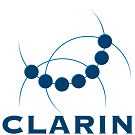Basic language processing: Difference between revisions
No edit summary |
Marked this version for translation |
||
| Line 1: | Line 1: | ||
<translate> | <translate> | ||
<!--T:1--> | |||
Under basis language processing, we understand part-of-speech tagging, lemmatization, named entity recognition, chunking and similar tasks which label individual words. | Under basis language processing, we understand part-of-speech tagging, lemmatization, named entity recognition, chunking and similar tasks which label individual words. | ||
<!--T:2--> | |||
== Frog == | == Frog == | ||
Frog is an integration of memory-based natural language processing (NLP) modules developed for Dutch. Frog's current version will tokenize, tag, lemmatize, and morphologically segment word tokens in Dutch text files, will assign a dependency graph to each sentence, will identify the base phrase chunks in the sentence, and will attempt to find and label all named entities. | Frog is an integration of memory-based natural language processing (NLP) modules developed for Dutch. Frog's current version will tokenize, tag, lemmatize, and morphologically segment word tokens in Dutch text files, will assign a dependency graph to each sentence, will identify the base phrase chunks in the sentence, and will attempt to find and label all named entities. | ||
<!--T:3--> | |||
*[https://webservices.cls.ru.nl/frog Online version] | *[https://webservices.cls.ru.nl/frog Online version] | ||
*[https://languagemachines.github.io/frog/ Project website] | *[https://languagemachines.github.io/frog/ Project website] | ||
<!--T:4--> | |||
== DeepFrog == | == DeepFrog == | ||
DeepFrog aims to be a (partial) successor of the Dutch-NLP suite Frog. Whereas the various NLP modules in Frog were built on k-NN classifiers, DeepFrog builds on deep learning techniques and can use a variety of neural transformers. | DeepFrog aims to be a (partial) successor of the Dutch-NLP suite Frog. Whereas the various NLP modules in Frog were built on k-NN classifiers, DeepFrog builds on deep learning techniques and can use a variety of neural transformers. | ||
<!--T:5--> | |||
*[https://huggingface.co/proycon/robbert-pos-cased-deepfrog-nld POS tagger] | *[https://huggingface.co/proycon/robbert-pos-cased-deepfrog-nld POS tagger] | ||
<!--T:6--> | |||
The system is not yet officially released. | The system is not yet officially released. | ||
*[https://github.com/proycon/deepfrog Github page] | *[https://github.com/proycon/deepfrog Github page] | ||
<!--T:7--> | |||
== LeTs == | == LeTs == | ||
LeTs is preprocessor that can be used for Dutch, German, English and French. | LeTs is preprocessor that can be used for Dutch, German, English and French. | ||
<!--T:8--> | |||
*[https://lt3.ugent.be/resources/lets/ Project page] | *[https://lt3.ugent.be/resources/lets/ Project page] | ||
*[https://lt3.ugent.be/lets-demo/ Demo] | *[https://lt3.ugent.be/lets-demo/ Demo] | ||
== Spacy == | == Spacy == <!--T:9--> | ||
<!--T:10--> | |||
[https://spacy.io/models/nl Dutch models] | [https://spacy.io/models/nl Dutch models] | ||
<!--T:11--> | |||
== Stanza == | == Stanza == | ||
A Python NLP Package for Many Human Languages | A Python NLP Package for Many Human Languages | ||
<!--T:12--> | |||
* [https://stanfordnlp.github.io/stanza/#stanza--a-python-nlp-package-for-many-human-languages Stanza github pages] | * [https://stanfordnlp.github.io/stanza/#stanza--a-python-nlp-package-for-many-human-languages Stanza github pages] | ||
<!--T:13--> | |||
==Adelheid Tagger-Lemmatizer: A Distributed Lemmatizer for Historical Dutch== | ==Adelheid Tagger-Lemmatizer: A Distributed Lemmatizer for Historical Dutch== | ||
With this web-application an end user can have historical Dutch texts tokenized, lemmatized and part-of-speech tagged, using the most appropriate resources (such as lexica) for the text in question. For each specific text, the user can select the best resources from those available in CLARIN, wherever they might reside, and where necessary supplemented by own lexica. | With this web-application an end user can have historical Dutch texts tokenized, lemmatized and part-of-speech tagged, using the most appropriate resources (such as lexica) for the text in question. For each specific text, the user can select the best resources from those available in CLARIN, wherever they might reside, and where necessary supplemented by own lexica. | ||
<!--T:14--> | |||
*[http://portal.clarin.nl/node/1918 CLAPOP page] | *[http://portal.clarin.nl/node/1918 CLAPOP page] | ||
*No working version found | *No working version found | ||
</translate> | </translate> | ||
Revision as of 14:48, 26 March 2024
Under basis language processing, we understand part-of-speech tagging, lemmatization, named entity recognition, chunking and similar tasks which label individual words.
Frog
Frog is an integration of memory-based natural language processing (NLP) modules developed for Dutch. Frog's current version will tokenize, tag, lemmatize, and morphologically segment word tokens in Dutch text files, will assign a dependency graph to each sentence, will identify the base phrase chunks in the sentence, and will attempt to find and label all named entities.
DeepFrog
DeepFrog aims to be a (partial) successor of the Dutch-NLP suite Frog. Whereas the various NLP modules in Frog were built on k-NN classifiers, DeepFrog builds on deep learning techniques and can use a variety of neural transformers.
The system is not yet officially released.
LeTs
LeTs is preprocessor that can be used for Dutch, German, English and French.
Spacy
Stanza
A Python NLP Package for Many Human Languages
Adelheid Tagger-Lemmatizer: A Distributed Lemmatizer for Historical Dutch
With this web-application an end user can have historical Dutch texts tokenized, lemmatized and part-of-speech tagged, using the most appropriate resources (such as lexica) for the text in question. For each specific text, the user can select the best resources from those available in CLARIN, wherever they might reside, and where necessary supplemented by own lexica.
- CLAPOP page
- No working version found
